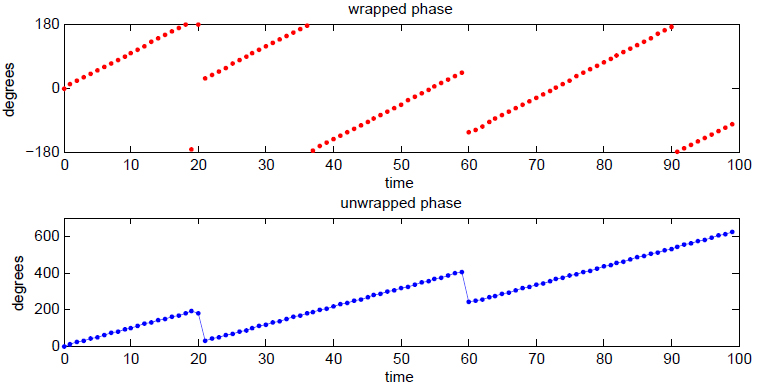Instantaneous Phase And Frequency on:
[Wikipedia]
[Google]
[Amazon]
Instantaneous phase and frequency are important concepts in signal processing that occur in the context of the representation and analysis of time-varying functions. The instantaneous phase (also known as local phase or simply phase) of a ''complex-valued'' function ''s''(''t''), is the real-valued function:
:
where arg is the complex argument function.
The instantaneous frequency is the 
temporal rate of change
In mathematics, a rate is the ratio between two related quantity, quantities in different units. If the denominator of the ratio is expressed as a single unit of one of these quantities, and if it is assumed that this quantity can be changed syst ...
of the instantaneous phase.
And for a ''real-valued'' function ''s''(''t''), it is determined from the function's analytic representation
In mathematics and signal processing, an analytic signal is a complex-valued function that has no negative frequency components. The real and imaginary parts of an analytic signal are real-valued functions related to each other by the Hilber ...
, ''s''a(''t''):
:
where represents the Hilbert transform of ''s''(''t'').
When ''φ''(''t'') is constrained to its principal value
In mathematics, specifically complex analysis, the principal values of a multivalued function are the values along one chosen branch of that function, so that it is single-valued. The simplest case arises in taking the square root of a positive ...
, either the interval or , it is called ''wrapped phase''. Otherwise it is called ''unwrapped phase'', which is a continuous function of argument ''t'', assuming ''s''a(''t'') is a continuous function of ''t''. Unless otherwise indicated, the continuous form should be inferred.

Examples
Example 1
: where ''ω'' > 0. : In this simple sinusoidal example, the constant ''θ'' is also commonly referred to as ''phase'' or ''phase offset''. ''φ''(''t'') is a function of time; ''θ'' is not. In the next example, we also see that the phase offset of a real-valued sinusoid is ambiguous unless a reference (sin or cos) is specified. ''φ''(''t'') is unambiguously defined.Example 2
: where ''ω'' > 0. : In both examples the local maxima of ''s''(''t'') correspond to ''φ''(''t'') = 2''N'' for integer values of ''N''. This has applications in the field of computer vision.Instantaneous frequency
Instantaneous angular frequency is defined as: : and instantaneous (ordinary) frequency is defined as: : where ''φ''(''t'') must be the unwrapped phase; otherwise, if ''φ''(''t'') is wrapped, discontinuities in ''φ''(''t'') will result in Dirac delta impulses in ''f''(''t''). The inverse operation, which always unwraps phase, is: : This instantaneous frequency, ''ω''(''t''), can be derived directly from the real and imaginary parts of ''s''a(''t''), instead of the complex arg without concern of phase unwrapping. : 2''m''1 and ''m''2 are the integer multiples of necessary to add to unwrap the phase. At values of time, ''t'', where there is no change to integer ''m''2, the derivative of ''φ''(''t'') is : For discrete-time functions, this can be written as a recursion: : Discontinuities can then be removed by adding 2 whenever Δ''φ'' 'n''≤ −, and subtracting 2 whenever Δ''φ'' 'n''nbsp;> . That allows ''φ'' 'n''to accumulate without limit and produces an unwrapped instantaneous phase. An equivalent formulation that replaces the modulo 2 operation with a complex multiplication is: : where the asterisk denotes complex conjugate. The discrete-time instantaneous frequency (in units of radians per sample) is simply the advancement of phase for that sample :Complex representation
In some applications, such as averaging the values of phase at several moments of time, it may be useful to convert each value to a complex number, or vector representation: : This representation is similar to the wrapped phase representation in that it does not distinguish between multiples of 2 in the phase, but similar to the unwrapped phase representation since it is continuous. A vector-average phase can be obtained as thearg
Arg or ARG may refer to:
Places
*''Arg'' () means "citadel" in Persian, and may refer to:
**Arg, Iran, a village in Fars Province, Iran
**Arg (Kabul), presidential palace in Kabul, Afghanistan
**Arg, South Khorasan, a village in South Khorasan P ...
of the sum of the complex numbers without concern about wrap-around.
See also
* Analytic signal * Frequency modulation * Group delay * Instantaneous amplitude * Negative frequencyReferences
Further reading
* *{{cite book , last1=Granlund , last2=Knutsson , title=Signal Processing for Computer Vision , publisher=Kluwer Academic Publishers , year=1995 Signal processing Digital signal processing Time–frequency analysis Fourier analysis Electrical engineering Audio engineering